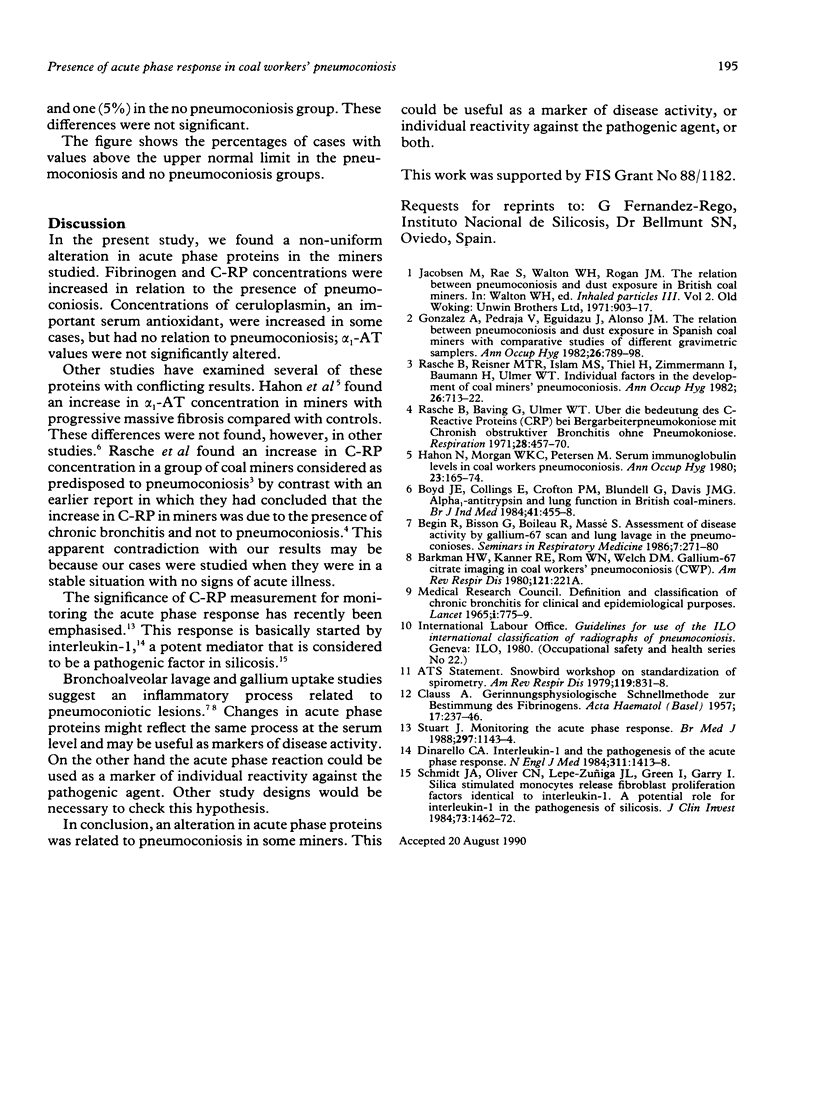Abstract
To evaluate the role of personal factors in pneumoconiosis, several acute phase proteins were studied in 62 coal miners without acute illnesses and classified as having no pneumoconiosis (n = 19), simple pneumoconiosis (n = 23), or complicated pneumoconiosis with progressive massive fibrosis (n = 20). Groups were similar for age, years of work at high risk jobs, chronic bronchitis, and forced expiratory volume in one second (FEV1). C-reactive protein concentration was significantly higher in the simple and complicated pneumoconiosis groups in comparison with the no pneumoconiosis group. The C-reactive protein concentration was above the upper normal value in 12 (27.9%) out of 43 cases with simple and complicated pneumoconiosis. On the other hand only one case of no pneumoconiosis was above the upper normal range (5.3%), a significant difference taking into account a stratified analysis for chronic bronchitis. Fibrinogen concentration was significantly increased in the simple pneumoconiosis group compared with the no pneumoconiosis group. The value of fibrinogen was above the upper normal limit in 17 out of the 43 cases with pneumoconiosis (39.5%) by contrast with two cases in the no pneumoconiosis group (10.5%). No significant differences in alpha 1-antitrypsin and ceruloplasmin concentrations were found between groups. In conclusion, an alteration in some acute phase proteins related to pneumoconiosis was found in miners. This could be used as a marker of disease activity and personal response against the pathogenic agent.
Full text
PDF


Selected References
These references are in PubMed. This may not be the complete list of references from this article.
- Boyd J. E., Collings P., Crofton P. M., Blundell G., Davis J. M. Alpha 1 antitrypsin and lung function in British coalminers. Br J Ind Med. 1984 Nov;41(4):455–458. doi: 10.1136/oem.41.4.455. [DOI] [PMC free article] [PubMed] [Google Scholar]
- CLAUSS A. Gerinnungsphysiologische Schnellmethode zur Bestimmung des Fibrinogens. Acta Haematol. 1957 Apr;17(4):237–246. doi: 10.1159/000205234. [DOI] [PubMed] [Google Scholar]
- Dinarello C. A. Interleukin-1 and the pathogenesis of the acute-phase response. N Engl J Med. 1984 Nov 29;311(22):1413–1418. doi: 10.1056/NEJM198411293112205. [DOI] [PubMed] [Google Scholar]
- Gonzalez A., de la Pedraja V., Eguidazu J., Alonso J. M. The relation between pneumoconiosis and dust exposure in Spanish coal mines with comparative studies of different gravimetric dust samplers. Ann Occup Hyg. 1982;26(1-4):789–797. [PubMed] [Google Scholar]
- Hahon N., Morgan W. K., Petersen M. Serum immunoglobulin levels in coal workers' pneumoconiosis. Ann Occup Hyg. 1980;23(2):165–174. doi: 10.1093/annhyg/23.2.165. [DOI] [PubMed] [Google Scholar]
- Jacobsen M., Rae S., Walton W. H., Rogan J. M. The relation between pneumoconiosis and dust-exposure in British coal mines. Inhaled Part. 1970;2:903–919. [PubMed] [Google Scholar]
- Lock S. NHS 1948-88: less ideology, more humanity. BMJ. 1988 Jul 2;297(6640):1–3. doi: 10.1136/bmj.297.6640.1. [DOI] [PMC free article] [PubMed] [Google Scholar]
- Rasche B., Baving G., Ulmer W. T. Uber die Bedeutung des C-reaktiven Proteins (CRP) bei Bergarbeiterpneumokoniose mit chronisch obstruktiver Bronchitis und bei chronisch obstruktiver Bronchtiis ohne Pneumokoniose. Respiration. 1971;28(5):457–470. doi: 10.1159/000192831. [DOI] [PubMed] [Google Scholar]
- Rasche B., Reisner M. T., Islam M. S., Thiel H., Zimmermann I., Baumann H., Ulmer W. T. Individual factors in the development of coal miners' pneumoconiosis. Ann Occup Hyg. 1982;26(1-4):713–722. [PubMed] [Google Scholar]
- Schmidt J. A., Oliver C. N., Lepe-Zuniga J. L., Green I., Gery I. Silica-stimulated monocytes release fibroblast proliferation factors identical to interleukin 1. A potential role for interleukin 1 in the pathogenesis of silicosis. J Clin Invest. 1984 May;73(5):1462–1472. doi: 10.1172/JCI111350. [DOI] [PMC free article] [PubMed] [Google Scholar]


